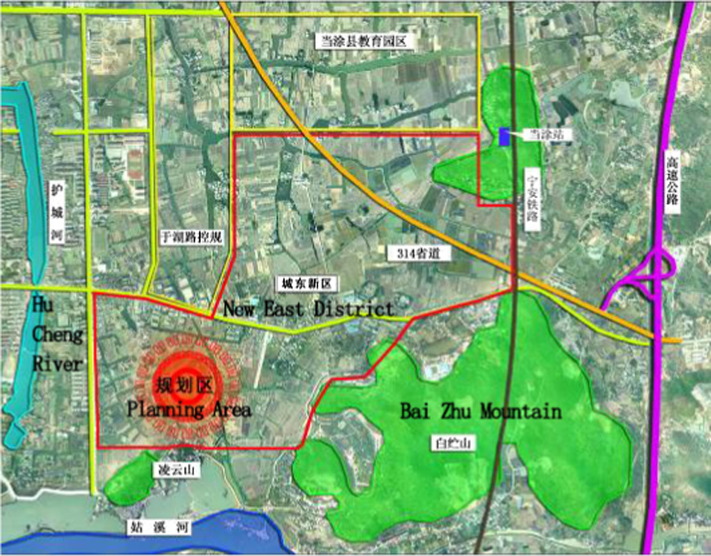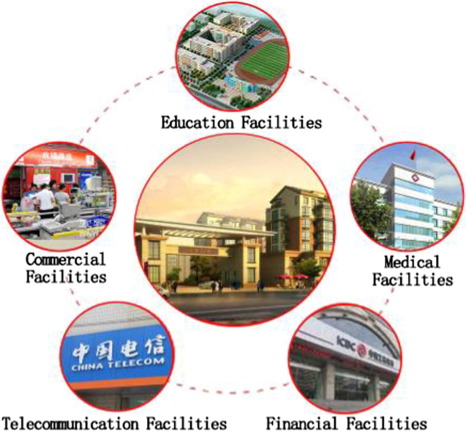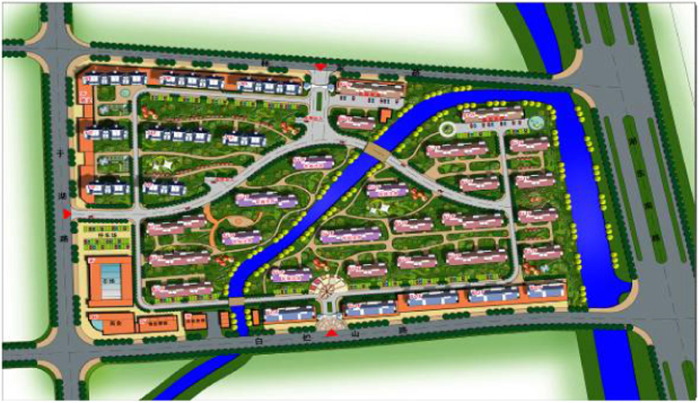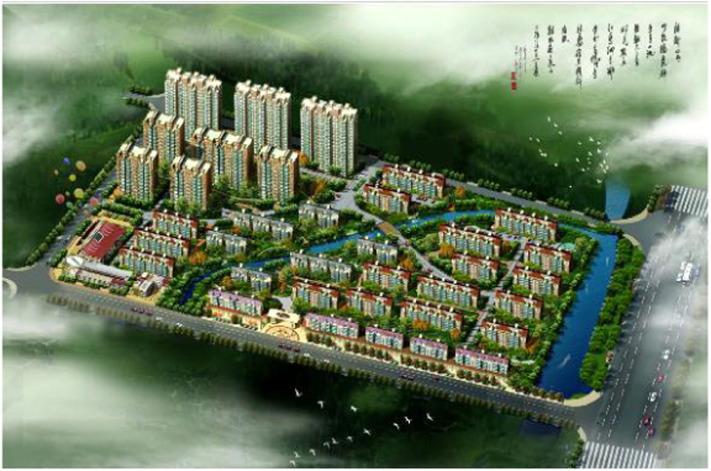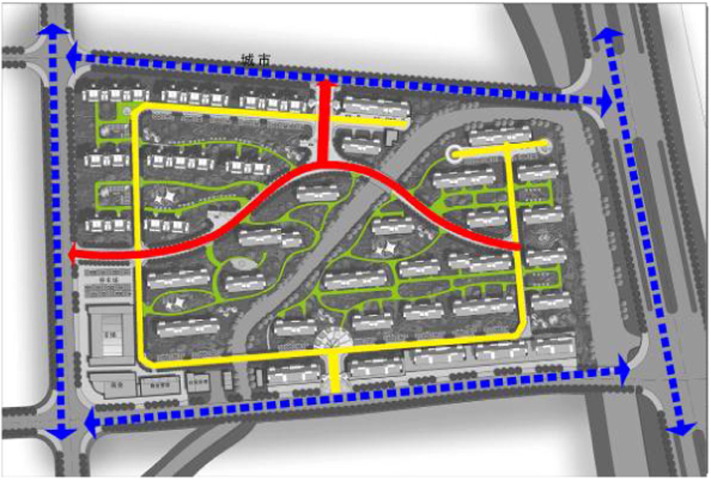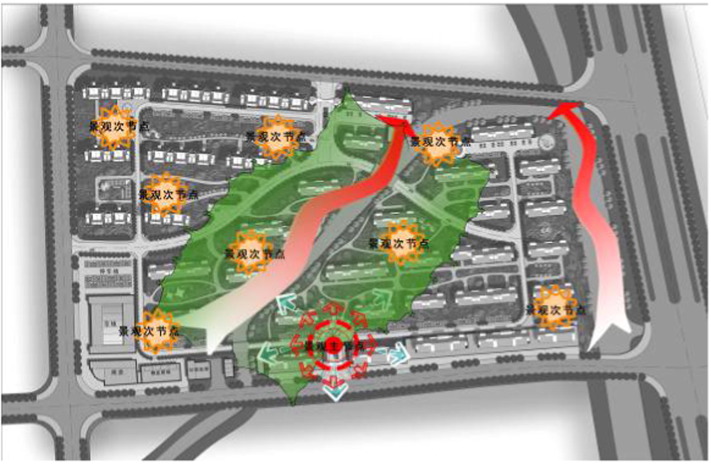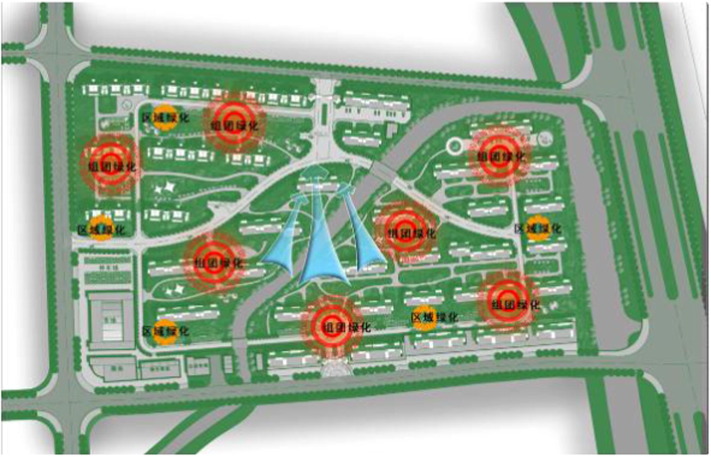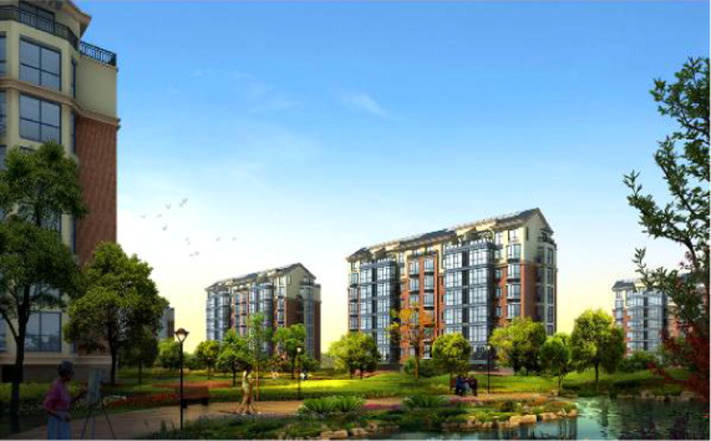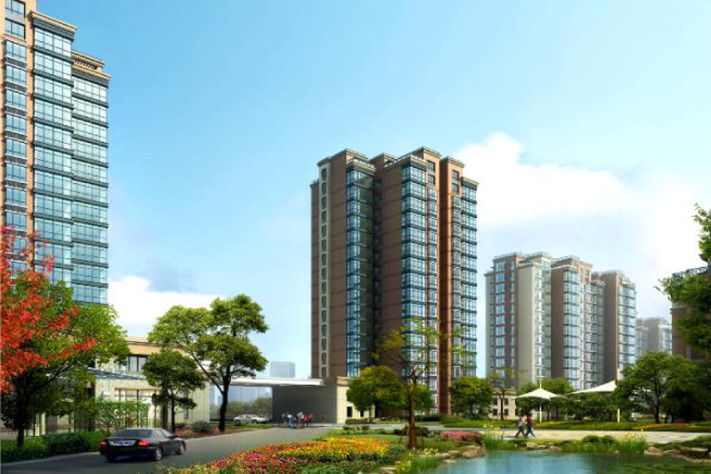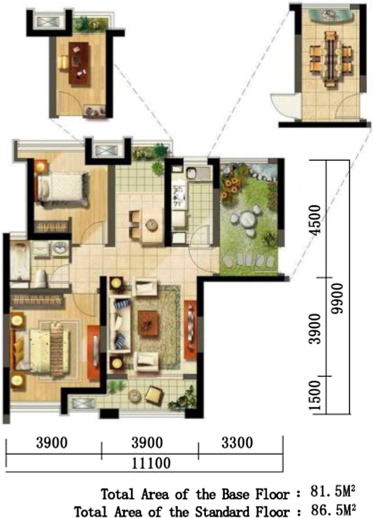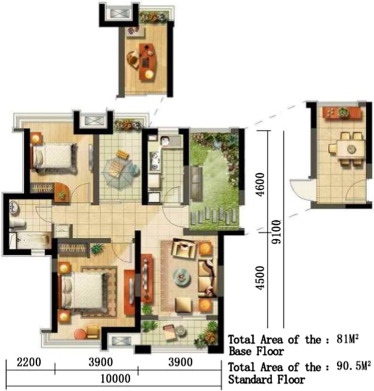Abstract
This paper takes the second-stage Guxi Shanshui Residential District in Dang Tu County as an example to analyze the characteristics of it from the aspects of function, traffic, landscape, and house types. And we explore the planning and design of the modern residential district by this research, and hope to make useful contributions to the development and construction of the future residential district planning and design.
Keywords
Residential district; Planning and design; Sustainable development
1. Introduction
With the rapid development of the modern cities, various urban planning conceptions are changing from the single material planning to the proposition of ecological city, healthy city, and garden city which pilot the development direction of the city from different aspects in different times [1]. Residential districts are regarded as the urban cells, and their planning conceptions play a very important part during the development process of the city. The humanistic planning trend of focusing on the individual fate and people’s mental activities forms the idea of “Community Planning” and work method in modern cities along with the rapid development of the material civilization [2]. This paper takes the second-stage Guxi Shanshui Residential District in Dang Tu County as an example to analyze the characteristics of it from the aspects of function, traffic, landscape, and house types. And we explore the planning and design of the modern residential district by this research, and hope to make useful contributions to the development and construction of the future residential district planning and design.
2. Project overview
2.1. Location
The planning area is located in the Dang Tu County, Ma’anshan City. The main city roads surrounding it include Zhen Xing Road, Lin Jia Road, Hu Dongnan Road, Bai Zhushan Road, Yu Hu Road, and Ling Yun Road. The second-stage project lies in the west side of Hu Dongnan Road, the south side of Lin Jia Road, the north side of Bai Zhushan Road, and the east side of Yu Hu Road, and the total area is about 10.3 ha.
2.2. Current environment
There are two rivers run through the second-stage planning area, and divide it into two groups. The first-stage Guxi Shanshui Residential District is located in the south side of Bai Zhushan Road. The existed residential districts include the No. 1 He He Village, No. 2 He He Village, Dongsheng Blue Bay; the supporting facilities include the He He Market, Angel Kindergarten, Shanghai Hao Meijia Supermarket, and Dong Meng Hospital within one kilometer radius from the second-stage planning area. The planning area has a very great fengshui for the reason of adjoining the Hu Cheng River in the west side and Ling Yun Mountain in the south side. Along with the rapid development of the Xiang Bei Industrial District, Gu Xiang Industrial District, and Gu Nan Industrial District, the residence of the old town will become saturated. Therefore, the New East Town will become an important development place in the future, and the Guxi Shanshui Residential Districts are located in the best places of the new area (Fig. 1).
|
|
|
Figure 1. Current environment of the planning area. |
2.3. Advantages of this project
This project, supplemented by the “New East District Planning”, will boast convenient traffic, concentrated population, good urban infrastructure, and well developed service facilities for commercial and cultural activities, etc (Fig. 2). The abundant river systems will be the highlight base to lay the foundation of creating ecological and waterfront residential district.
|
|
|
Figure 2. Five gathered supporting facilities of the planning area. |
3. Overall thinking of the planning and design
3.1. Developing the advantages of the base and emphasizing the spatial continuity
Under the situation of high convenient traffic, we should develop the central advantage of this project. Meanwhile, it is surrounded by residential districts in south, north, and west side. Therefore, we arrange commercial buildings, commercial housing buildings, and community service buildings along the three urban roads. This will enclose the living space in the middle of the planning area. In addition, we will take full use of the existed river systems to develop waterfront landscape, and arrange some villas around it to enhance the grade of this residential district (Figure 3 and Figure 4).
|
|
|
Figure 3. General layout of the second-stage Guxi Shanshui residential district. |
|
|
|
Figure 4. A bird-eye view of the second-stage Guxi Shanshui residential district. |
3.2. Organizing people-oriented traffic system
According to the analysis of the location, we set two main entrances in south Bai Zhushan Road and north Lin Jia Road: consider the layout of supporting facilities in west Yu Hu Road and make it to be the service and parking place entrance. The entrance layout of the parking place should be combined with the underground garages planning of the market. And it is not suitable to set entrance in east Hu Dongnan Road for the reason of its high grade.
The planning roads are divided into three grades, the main road, secondary roads, and house roads. The main road refers to the road in a dynamic form that connects the entrances in east and west. It extends the visual space and reveals the smooth and natural beauty by the distinctive landscape and buildings at random change. The roadway width of the main road is 8 m.
The conception of separation of vehicles and people is applied to the inner residential district planning, which can guarantee the integrity and naturality. The separation will make the vehicles convenient to arrive at each household and reduce the interference to the open space. In this planning, we seriously carry out the people-oriented conception and design the roads with obvious classification (Fig. 5).
|
|
|
Figure 5. Traffic planning. |
3.3. Creating open landscape
The landscape design of the residential district should highlight the local characteristics, and yield the greatest ecological, social and economical returns [3]. The open landscape system pays attention to the integration of the square space, street space, green space and building courtyard space, and makes full use of the existed water system to highlight the individual design [4].
For the landscape of the Guxi Shanshui, we adopt dynamic water systems as the landscape radiation source which covers the whole planning area. In addition, we regard the small open space, such as squares and courtyards as important node elements to make the landscape of the residential district to be systematic and networking. And it will greatly improve the living quality (Fig. 6) [5].
|
|
|
Figure 6. Landscape analysis. |
The landscaping form of the planning residential district mainly consists of grassland, shrubs, trees, and roof plantation [6]. Meanwhile, by combining with the water landscape, outdoor playgrounds and landscape opusculums, we hope to form a diversity-rich environment. The living groups are relatively independent, and the green lands of them are combined together to form a system [7]. The walking green landscape axis runs from the east to the west. In addition, the methods of view borrowing and filtering are widely used in the square design (Fig. 7) [8].
|
|
|
Figure 7. Green system planning. |
3.4. Buildings and house types
During the architectural design process of the Second-stage Guxi Shanshui Residential District, we absorb some different modern elements and integrate them harmoniously together when we conduct the design of architectural facades. In the aspect of architectural colors, we adopt warm colors to create a warm and harmonious atmosphere in the residential district. In the aspect of architectural forms, we adopt the principle of diversity, such as the ordinary multi-story dwellings, sub-high rise dwellings, high rise dwellings, and villas. After the reasonable planning, the architectural forms will not only enrich the urban sky line but also meet the requirements of different households. Architectural colors and forms should integrate with the functions and landscape characteristics in different places [9]. Meanwhile, architectural forms and space planning should have a cordial and pleasant scale, reflect the designer’s care to the users, and make the residents living in it have the sense of belonging and pride (Figs. 8 and 9) [10].
|
|
|
Figure 8. Effect pictures of multi-story dwellings. |
|
|
|
Figure 9. Effect pictures of high-rise dwellings. |
In order to guarantee the daylight of the whole planning area, we stagger the buildings to get the best results of daylight and ventilation.
In the aspect of house types, we fully consider local people’s living habits, and adopt the principles of setting terrace in the spring layer, bright bathroom and kitchen, facing the south [11]. Meanwhile, we pay attention to the feature-oriented design, and design a garden entrance to increase the visual beauty and living interest [12]. Meanwhile, we insist inheriting the traditional courtyard culture and making it to be continuous and rich. In order to meet the different requirements of different people, we should also pay attention to the diversity and variety of the house style design (Figure 10 and Figure 11).
|
|
|
Figure 10. House style design. |
|
|
|
Figure 11. House style design. |
4. Conclusion
This paper takes the second-stage Guxi Shanshui Residential District in Dang Tu County as an example to analyze the characteristics of it from the aspects of function, traffic, landscape, and house types. And we explore the planning and design of the modern residential district by this research, and hope to make useful contributions to the development and construction of the future residential district planning and design. During the process of planning and design, we should hold the people-oriented line and implement it into the planning. And this is what the designers should pursue for.
Acknowledgments
This work was financially supported by the National “Twelfth Five-Year” Science & Technology Support Plan: the city high density space efficiency optimization key technology research (Subject Numbers: 2012BAJ15B03).
References
- [1] Weian Liu; Some thoughts of the livable urban planning; Chin. Overseas Archit. (7) (2009)
- [2] Jinsong Jiang, Binyao Lin; The thoughts of China’s urban planning theory, methods and systems; Urban Plann. J. (3) (2004)
- [3] Jiajun Fan; Brief analysis of the residential district planning; Shanxi Archit., 30 (24) (2004)
- [4] Jihong Zhou; Research on the residential district planning; Chin. Overseas Archit. (7) (2008)
- [5] Zhen Tian; From thought to image—thought and expression of conceptual design in architectural creation; Huazhong Archit. (01) (2002)
- [6] Yanmei Gao; Concept design of residential areas planning; Archit. Sci., 25 (4) (2009)
- [7] Fei Li; Residential theory concept review and adjustment of “City residential district planning and design specification”; City Plann. Rev. (3) (2011)
- [8] Hao Gu; Source in natural environment characteristics––Hangzhou “Urban village” residential district planning and design; Planner, 19 (11) (2003)
- [9] Ying Ren, Jiawen Li, Xuehong Zhan; Based on the “4C” marketing science literature on residential district planning concept; Urban Plann., 31 (2) (2007)
- [10] James W. Axley, Steven J. Emmerich, A method to assess the suitability of a climate for natural ventilation of commercial buildings, in: Proceedings Indoor Air. Monterey, 2002, pp. 854–859.
- [11] C. Ghiaus, R. Belarbi, F. Allard, Evaluaion of natural ventilation potential by using degree-days, in: International Forum on Renewalbe Engrgies FIER’2002 Proceedins, Tanyer, 2002, pp. 467–473.
- [12] S.J. Emmerich, W.S. Dols, J.W. Axley; Natural ventilation review and plan for design and analysis tools; National Institute of Standard and Technology, Gaithersburg (2001)
Document information
Published on 12/04/17
Licence: Other
Share this document
claim authorship
Are you one of the authors of this document?
